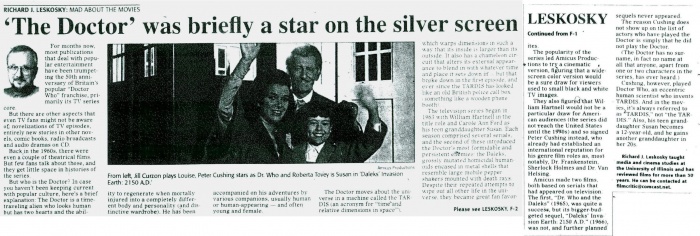The Doctor was briefly a star on the silver screen
- Publication: Champaign News-Gazette
- Date: 2013-11-24
- Author: Richard J. Leskosky
- Page: F-1
- Language: English
For months now, most publications that deal with popular entertainment have been trumpeting the 50th anniversary of Britain's popular "Doctor Who" franchise, primarily its TV series core.
But there are other aspects that even TV fans might not be aware of: novelizations of TV episodes, entirely new stories in other novels, comic books, radio broadcasts and audio dramas on CD.
Back in the 1960s, there were even a couple of theatrical films. But few fans talk about those, and they get little space in histories of the series.
But who is the Doctor? In case you haven't been keeping current with popular culture, here's a brief explanation: The Doctor is a time-traveling alien who looks human but has two hearts and the ability to regenerate when mortally injured into a completely different body and personality (and distinctive wardrobe). He has been accompanied on his adventures by various companions, usually human or human-appearing — and often young and female.
The Doctor moves about the universe in a machine called the TARDIS (an acronym for "time and relative dimensions in space"), which warps dimensions in such a way that its inside is larger than its outside. It also has a chameleon circuit that alters its external appearance to blend in with whatever time and place it sets down in ... but that broke down in the first episode, and ever since the TARDIS has looked like an old British police call box (something like a wooden phone booth).
The television series began in 1963 with William Hartnell in the title role and Carole Ann Ford as his teen granddaughter Susan. Each season comprised several serials, and the second of these introduced the Doctor's most formidable and persistent enemies: the Daleks, grossly mutated homicidal humanoids encased in metal shells that resemble large mobile pepper shakers mounted with death rays. Despite their repeated attempts to wipe out all other life in the universe, they became great fan favorites.
The popularity of the series led Amicus Productions to try a cinematic version, figuring that a wide-screen color version would be a sure draw for viewers used to small black and white TV images.
They also figured that William Hartnell would not be a particular draw for American audiences (the series did not reach the United States until the 1970s) and so signed Peter Cushing instead, who already had established an international reputation for his genre film roles as, most notably, Dr. Frankenstein, Sherlock Holmes and Dr. Van Helsing.
Amicus made two films, both based on serials that had appeared on television. The first, "Dr. Who and the Daleks" (1965), was quite a success, but its bigger-budgeted sequel, "Daleks' Invasion Earth: 2150 A.D." (1966), was not, and further planned sequels never appeared.
The reason Cushing does not show up on the list of actors who have played the Doctor is simply that he did not play the Doctor.
(The Doctor has no surname, in fact no name at all that anyone, apart from one or two characters in the series, has ever heard.)
Cushing, however, played Doctor Who, an eccentric human scientist who invents TARDIS. And in the movies, it's always referred to as "TARDIS," not "the TARDIS." Also, his teen granddaughter Susan becomes a 12-year-old, and he gains another granddaughter in her 20s.
Richard J. Leskosky taught media and cinema studies at the University of Illinois and has reviewed films for more than 30 years. He can be contacted at filmcritic@comcast.net.
Caption: Amicus Productions
From left, Jill Curzon plays Louise, Peter Cushing stars as Dr. Who and Roberta Tovey is Susan in 'Daleks' Invasion Earth: 2150 A.D.'
Disclaimer: These citations are created on-the-fly using primitive parsing techniques. You should double-check all citations. Send feedback to whovian@cuttingsarchive.org
- APA 6th ed.: Leskosky, Richard J. (2013-11-24). The Doctor was briefly a star on the silver screen. Champaign News-Gazette p. F-1.
- MLA 7th ed.: Leskosky, Richard J.. "The Doctor was briefly a star on the silver screen." Champaign News-Gazette [add city] 2013-11-24, F-1. Print.
- Chicago 15th ed.: Leskosky, Richard J.. "The Doctor was briefly a star on the silver screen." Champaign News-Gazette, edition, sec., 2013-11-24
- Turabian: Leskosky, Richard J.. "The Doctor was briefly a star on the silver screen." Champaign News-Gazette, 2013-11-24, section, F-1 edition.
- Wikipedia (this article): <ref>{{cite news| title=The Doctor was briefly a star on the silver screen | url=http://cuttingsarchive.org/index.php/The_Doctor_was_briefly_a_star_on_the_silver_screen | work=Champaign News-Gazette | pages=F-1 | date=2013-11-24 | via=Doctor Who Cuttings Archive | accessdate=21 December 2025 }}</ref>
- Wikipedia (this page): <ref>{{cite web | title=The Doctor was briefly a star on the silver screen | url=http://cuttingsarchive.org/index.php/The_Doctor_was_briefly_a_star_on_the_silver_screen | work=Doctor Who Cuttings Archive | accessdate=21 December 2025}}</ref>
